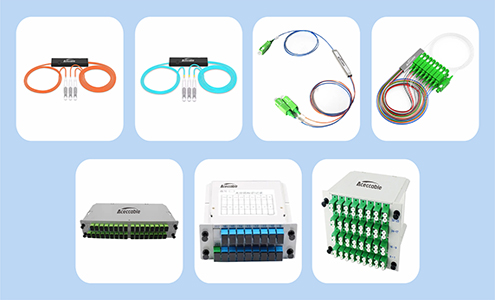RESEARCH ON THE CONSTRUCTION STRATEGY OF FIBER OPTIC FOR THE 5G ERA
With the arrival of the 5G era, large-scale base station construction projects are essential, and transmission resources are becoming increasingly scarce. This article analyzes various instance construction schemes for the application of optical multiplexing equipment based on its working principle, and provides application value, which can effectively achieve the goal of rapid website construction.
Throughout the development of mobile communication society, people have never stopped pursuing higher performance networks. With the rise of new technologies such as the Internet of Things and the Internet of Vehicles, the era of the Internet of Things is approaching. Currently, communication networks mainly in the form of 4G networks will not be able to meet the needs of massive device connections and explosive data traffic growth. Therefore, 5G will inevitably emerge, and the construction of large-scale 5G networks has become increasingly urgent. However, considering the current carrying capacity of the transmission network, large-scale station construction will inevitably lead to a significant occupation of fiber core resources, which is bound to bring significant load to the entire transmission network.
In addition, there are difficulties in property coordination and long regeneration cycles in the construction of transmission networks, so it is particularly important to use fiber core reuse products to achieve rapid reconstruction of access network optical cables.
In order to meet the needs of 5G construction, this article proposes a construction plan that uses fiber optic multiplexing equipment to achieve rapid reconstruction of optical cables. This solution can effectively solve the problem of insufficient fiber core resources in the transmission network but the need to quickly complete business access. It can carry the access business requirements on limited fiber core resources, thereby releasing idle fiber cores to complete other business access.
Fiber optic multiplexing equipment essentially utilizes 8-16 wavelengths of coarse wavelength division to perform wavelength division multiplexing, which can combine optical signals of different wavelengths into a single beam of light, which is then decomposed at the receiving end to achieve single fiber multi wavelength division [2] [3]. At present, the main manufacturers in the market include Rexroth, FiberHome, etc. The new fiber optic multiplexing equipment products mainly include four types: 1:6 aggregation, 1:8 aggregation, 1:12 aggregation, and 1:18 aggregation. The wavelength ranges from 1271nm to 1611nm, and the number of channels that can be synthesized or separated are 6, 8, 12, and 18, respectively. The maximum transmission capacity can reach 80Gbit/s, supporting multiple network frequency bands such as 2G, 3G, 4G, and 5G. Compared with old-fashioned wavelength division multiplexing equipment, this new type of fiber optic multiplexing equipment is more advanced in technology, with more exquisite appearance, quality, and form. It can be applied in various network construction environments, and can be deployed in multiple ways to timely alleviate the problem of insufficient fiber cores caused by large-scale station construction.
In the construction plan of 4G network base stations, major operators classify base stations according to their physical location and station size. This article classifies them according to macro stations, micro stations, and substation stations. Taking macro stations as an example, we explain the construction strategy of fiber optic multiplexing equipment. Firstly, we define the baseband processing unit (BBU) and radio frequency processing unit (RRU) as BBU and RRU respectively. The BBU and RRU transmit optical signals through optical modules, and the RRU and antenna are connected through feeders to amplify the signals and form three sectors, thus achieving signal coverage effect. Therefore, in this article, we consider the three RRUs that make up a base station as a group
A set of 1:6 aggregated optical multiplexing equipment consists of two fiber optic extenders. The network construction strategy is to use one set in each defined optical direction, and the fiber core resources can be quickly expanded. The specific solution is to place the matching fiber optic extenders on the near end BBU side. To access the corresponding three RRUs, three optical ports are selected from the BBU and connected using 10Gbit/s color optical modules with wavelengths of 1271nm, 1311nm, and 1351nm. At this point, the services of the three optical ports converge onto the single core bidirectional optical fiber on the line side through wavelength division multiplexing technology, and are transmitted to the optical junction box at the remote RRU through the optical fiber. To continue transmitting the optical signal to the remote RRU, another fiber optic extender is placed inside the optical junction box, and then connected to the RRU again through 10Gbit/s color optical modules at 1291nm, 1331nm, and 1371nm, respectively, to achieve optical path interconnection between the near end BBU and the far end RRU, thus completing the network construction.
Application scenarios of fiber optic multiplexing equipment in 5G construction
The application of fiber optic multiplexing equipment in 4G networks is becoming increasingly mature. In the complex 5G network construction scenarios, fast fiber optic cable reconstruction can also be achieved through the use of fiber optic multiplexing equipment. Multiple AAUs can be connected to BBUs (CU+DU) using one pair or one fiber optic cable, achieving the goal of quickly building 5G networks.
3.1 Subway Tunnel 5G Network Construction Scenarios
As a densely populated area, the construction of 5G networks is essential for the subway. However, in actual engineering construction, the construction of transmission optical cable resources is often carried out by the subway company. The subway company owners often need to consider the investment cost of the three operators’ joint construction mode for optical cable construction, which leads to difficulties in coordinating and supplementing cables when deploying 5G networks.
Therefore, in order to accelerate the completion of 5G network construction, key areas of 5G construction can be deployed in advance among operators. Fiber optic multiplexing equipment can be used to expand the original fiber core resources and achieve rapid reconstruction in the transmission line section from “Station A (near end BBU)” to “Station B (far end AAU)” of the subway. The specific construction plan is shown in Figure 2. By using 1:12 aggregated fiber optic multiplexing equipment, the fiber optic resources between the original near end BBU and far end AAU can be excavated from the existing subway network, and then the optical signal can be transmitted to one fiber optic through wavelength division multiplexing technology. The fiber core resources can be completed with only one core, which has strong scalability for high-density 5G networks and is beneficial for special subway applications. Rapid and large-scale deployment of 5G networks in scenarios.
3.2 5G Access Network Construction Scenarios Based on C-RAN
The current C-RAN is a newly developed wireless access network architecture, in which the baseband processing units are centrally deployed to form a baseband unit pool, which can reduce the number of physical data centers, thereby reducing the space occupied by data centers and reducing construction investment. By utilizing high-speed optical transmission networks and distributed remote wireless modules, hierarchical collaboration between multiple cells can be achieved, achieving resource sharing and dynamic scheduling, and building high-quality, high-speed, and low-power wireless networks.
In the era of 4G network, C-RAN has not been widely used in the construction of base stations due to the limitations of transmission resources and the impact of early station building mode. However, in the post 4G era, in the face of the huge challenges brought by the rapid development of Internet enterprises, operators have proposed the concept of cost reduction and efficiency increase, and sustained profit growth in terms of energy consumption, operation and maintenance costs. Some provinces have begun to build stations in CRAN mode. Therefore, in the 5G era, adopting C-RAN access network architecture as the network networking solution will become a trend. However, under this construction mode, there is a high demand for fiber optic resources in the transmission network. Faced with fierce market competition, it is urgent to quickly reconstruct fiber optic resources and achieve rapid station construction.
In the traditional network construction method, the transmission equipment forms a ring shape, and the BBU equipment at each construction site is scattered and not centrally placed, so only 2-core optical fibers need to be occupied on the ring; The C-RAN network construction method is to centralize the BBUs corresponding to multiple sites, that is, to place the BBUs in a well located and suitable access data center, forming a BBU pool. This pooled data center is called the C-RAN data center. As shown in Figure 3, the BBU pool has a total of 3 BBUs and 9 AAUs (or RRUs) attached to it. According to the calculation, the required fiber core resources reach 18 cores. If direct fiber optic cables are used, network construction cannot be quickly completed.
To solve the problem under this construction mode, the 18 core fiber optic demand is converged in the fiber optic multiplexing equipment (1:18 aggregation) during network construction, occupying only 1 core loop shared fiber optic for transmission, saving a lot of fiber core resources, and quickly reconstructing fiber optic cable resources to complete C-RAN network construction.
3.3 Indoor Distribution System 5G Construction Scenarios
Before indoor distribution systems became an important scenario for 5G network coverage, there was a significant demand for fiber optic resources in the actual construction process. However, considering the complexity of indoor distribution construction scenarios, there are often situations where fiber optic cable resources in vertical shaft pipelines are utilized by monitoring and intercom equipment, resulting in insufficient fiber optic resources; Problems such as insufficient space reserved for laying new optical cable resources in infrastructure construction.
To solve these problems, fiber optic multiplexing equipment can be used to achieve rapid reconstruction of optical cables during the rapid deployment of 5G networks, meeting the construction requirements. As shown in Figure 2.3, in a certain 5G indoor distribution system construction plan, it was found through calculation that the original AAU required 36 core fiber resources, but the on-site situation could not meet the corresponding requirements. By using fiber optic multiplexing equipment (1:6 aggregation), the construction can be completed by occupying 6 core fiber cables in the optical junction box, thus saving 30 core fiber resources.
3.4 5G coverage scenarios such as high-speed railways
With the development of special high-speed scenarios such as high-speed railways, future transportation systems will move towards faster and more convenient speeds. Compared to 4G networks, 5G networks can support high-speed rail speeds of up to 500km/h and reduce interface latency by 90%, better meeting the needs of high-speed transportation network construction.
In the construction of high-speed railway 5G networks, BBU-AAU remote mode is the main network construction scheme. Under this scheme, the high-speed railway network coverage adopts the method of merging multiple AAU cells to form a single cell network. Correspondingly, all AAUs in a single cell can only be remotely connected to BBUs in the merged cell computer room. In addition, considering the characteristics of the regions and landforms that high-speed railways pass through, the spans are often longer, and the longer the span, the more AAUs will be merged, resulting in greater consumption of fiber core resources. Therefore, in this scenario, it is also possible to consider using optical multiplexing equipment to save fiber core resources and achieve the goal of rapid construction. As shown in Figure 6 of the high-speed railway construction network in a certain city, the BBU pool in the computer room pulls down 9 remote AAUs, requiring a total of 18 fiber optic cables. By utilizing fiber optic multiplexing equipment (1:6 aggregation), only 3 fiber optic cables are needed for construction, saving a lot of fiber core resources.
The application value of rapid reconstruction scheme for optical cable
Fiber optic multiplexing equipment, as a new type of equipment, adopts a plug-in type splitter structure, and its design, production, and procurement methods all meet the management standards of operators. As a passive device, fiber optic multiplexing equipment does not need to change the original active device network architecture. It only needs to be installed on the base station side and connected to the active device in the optical junction box, which can meet the needs of various construction scenarios and has strong scalability.
In terms of network construction, in areas where fiber optic resources are scarce and new fiber optic cables are unconditionally laid, traditional construction plans cannot meet the requirements of the construction period. The use of optical multiplexing equipment can quickly reconstruct optical cables, reduce fiber core resource consumption, significantly shorten station construction time, and achieve rapid and large-scale station construction. However, if fiber optic multiplexing equipment is frequently used, multiple residential areas may experience simultaneous network failures and disconnections. Therefore, it is necessary to comprehensively evaluate the actual situation of the area to determine the construction plan.
In terms of cost management, the era of large-scale 5G network construction is approaching, and engineering construction will face problems such as tight cycles, large workloads, and limited resources. The application of fiber optic multiplexing equipment can greatly reduce the property communication costs, construction time costs, and pipeline fiber optic cable construction costs caused by the construction of new optical cables. However, the introduction of new equipment will inevitably increase the training and rework work for users, which will also result in certain labor costs. Therefore, it is necessary to comprehensively evaluate the cost of individual projects to ensure that they have the effect of saving construction costs after use.
In terms of maintenance, the characteristics of wavelength division multiplexing devices in each manufacturer’s fiber optic multiplexing equipment are different. Good fiber optic multiplexing equipment has good optical performance indicators, transparent transmission channels, and low insertion loss of color light modules, which can achieve plug and play without the need for business configuration. Therefore, in terms of maintenance, suitable manufacturers should be selected as much as possible and sufficient spare parts should be prepared to complete maintenance work, so that maintenance reliability can be guaranteed.






